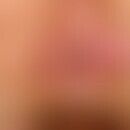DefinitionThis section has been translated automatically.
Benign, blue to blue-grey spots or patches that usually only become noticeable at the age of 30 or 40 and are histologically characterized by a proliferation of dermal, pigmented, spindle and/or dendritic cells. Acquired dermal melanocytosis occurs predominantly in the Asian population.
ClassificationThis section has been translated automatically.
The following subdivision can be made according to their distribution pattern:
- Facially localized acquired dermal melanocytosis (w>m)
- Extrafacially localized acquired dermal melanocytosis (m>w)
You might also be interested in
EtiopathogenesisThis section has been translated automatically.
Unknown. Genetic predisposition likely; people of Asian origin are more frequently affected. Reactivation of already latent melanocytes (Grimaux X et al. 2020)?
ClinicThis section has been translated automatically.
Facial, acquired dermal melanocytosis is similar to nevus ota. There are blurred, asymptomatic, brown patches of different colors, 2.0-5.0 cm in size, with normal hair.
The extrafacial, acquired dermal melanocytoses are similar to nevus Ito and are predominantly found on the trunk. There are blurred, asymptomatic, brown patches of varying color, 3.0-10.0 cm in size, with normal hair.
HistologyThis section has been translated automatically.
Histology: Loosely distributed S100+, MelanA+, HMB45+ and SOX10+ cells in the upper and middle dermis. No inflammatory infiltrates. The epidermis shows a normal distribution of melanocytes.
Progression/forecastThis section has been translated automatically.
Benign! There is no tendency to regression.
LiteratureThis section has been translated automatically.
- Baroody M, Holds JB (2004) Extensive locoregional malignant melanoma transformation in a patient with oculodermal melanocytosis. Plast Reconstr Surg 113: 317-322.
- Goncharuk V et al. (2003) Bednar tumor associated with dermal melanocytosis: melanocytic colonization or neuroectodermal multidirectional differentiation? J Cutan Pathol 30: 147-151.
- Grimaux X et al. (2020) An unusual brownish patch on the back of a 74-year-old Caucasian man. J Dtsch Dermatol Ges 18:638-640.
- Hanson M et al. (2003) Association of dermal melanocytosis with lysosomal storage disease: clinical features and hypotheses regarding pathogenesis. Arch Dermatol 139: 916-920
- Hyun DJ et al. (2016) Acquired dermal melanocytosis occurring in a patient with hyophidrotic ectodermal dysplasia. Ann Dermatol 28: 785-787
- Rubin AI et al. (2001) Acquired dermal melanocytosis: appearance during pregnancy. J Am Acad Dermatol 45: 609-613
Outgoing links (1)
Nevus of Ota;Disclaimer
Please ask your physician for a reliable diagnosis. This website is only meant as a reference.




